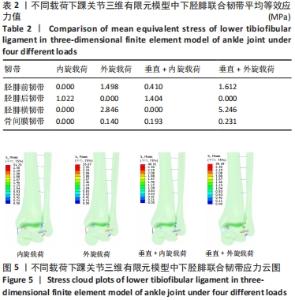[1] 王满宜.关于踝关节骨折伴下胫腓联合损伤的思考[J].中华创伤骨科杂志,2017,19(9):737-738.
[2] PORTER DA, JAGGERS RR, BARNES AF, et al. Optimal management of ankle syndesmosis injuries. Open Access J Sports Med. 2014;5:173-182.
[3] LIU GT, RYAN E, GUSTAFSON E, et al. Three-dimensional computed tomographic characterization of normal anatomic morphology and variations of the distal tibiofibular syndesmosis. J Foot Ankle Surg. 2018;57(6):1130-1136.
[4] IVINS D. Acute ankle sprain: an update. Am Fam Physician. 2006;74(10): 1714-1720.
[5] SUMANONT S, NOPAMASSIRI S, BOONROD A, et al. Acromioclavicular joint dislocation: a Dog Bone button fixation alone versus Dog Bone button fixation augmented with acromioclavicular repair—a finite element analysis study. Eur J Orthop Surg Traumatol. 2018;28(6):1095-1101.
[6] CHEUNG TM, ZHANG M, LEUNG KL, et al. Three-dimensional finite element analysis of the foot during standing—a material sensitivity study. J Biomech. 2005;38(5):1045-1054.
[7] CHEN FC, HUANG XW, YA YS, et al. Finite element analysis of intramedullary nailing and double locking plate for treating extra-articular proximal tibial fractures. J Orthop Surg Res. 2018;13(1):2-8.
[8] ATMACA H, OZKAN A, MATLA I, et al. The effect of proximal tibial corrective osteotomy on menisci tibia and tarsal bones: A finite element model study of tibia vara. Int J Med Robot. 2014;10(1):93-97.
[9] 刘清华.数字化人体足踝部三维有限元模型的建立及分析[D].广州:南方医科大学,2010.
[10] ANDERSON DD, GOLDSWORTHY JK, LI W, et al. Physical validation of a patient-specific contact finite element model of the ankle. J Biomech. 2007;40(8):1662-1669.
[11] 毕刚,陈大伟,李春光,等.下胫腓联合损伤对踝关节稳定性影响的生物力学研究[J].中国矫形外科杂志,2017,25(20):1881-1885.
[12] LIACOURAS PC, WAYNE JS. Computational modeling to predict mechanical function of joints: application to the lower leg with simulation of two cadaver studies.J Biomech Eng. 2007;129(6):811-817.
[13] 林健.下胫腓前韧带的功能与损伤修复[D].南京:南京医科大学, 2017.
[14] HERMANS JJ, BEUMER A, DE JONG TA, et al. Anatomy of the distal tibiofibular syndesmosis in adults: a pictorial essay with a multimodality approach. J Anat. 2010;217(6):633-645.
[15] LILYQUIST M, SHAW A, LATZ K, et al. Cadaveric analysis of the distal tibiofibular syndesmosis. Foot Ankle Int. 2016;37(8): 882-890.
[16] XENOS JS, HOPKINSON WJ, MULLIGAN ME, et al.The tibiofibular syndesmosis.Evaluation of the ligamentous structures,methods of fixation,and radiographic assessment. J Bone Joint Surg Am. 1995; 77(6):847-856.
[17] 王军,张铁骑,何益群,等.3D 打印踝穴位支具辅助术中透视评估下胫腓联合分离的应用价值[J].中国骨与关节损伤杂志,2020,35(6): 643-644.
[18] CLANTON TO, PAUL P. Syndesmosis injuries in athletes. Foot Ankle Clin. 2002;7(3):529-549.
[19] MORRIS M, RICE P, SCHNEIDER TE. Distal tibiofibular syndesmosis reconstruction using a free hamstring autograft. Foot Ankle Int. 2009; 30(6):506-511.
[20] PEA FA, CHRIS COETZEE J. Ankle Syndesmosis Injuries-ScienceDirect. Foot Ankle Clin. 2006;11(1):35-50.
[21] RAMMELT S, ZWIPP H, GRASS R. Injuries to the Distal Tibiofibular Syndesmosis: an Evidence-Based Approach to Acute and Chronic Lesions. Foot Ankle Clin. 2008;13(4):611-633.
[22] THORDARSON DB, MOTAMED S, HEDMAN T, et al. The effect of fibular malreduction on contact pressures in an ankle fracture malunion model. J Bone Joint Surg Am. 1998;79(12):1809-1815.
[23] VAN HEEST TJ, LAFFERTY PM. Injuries to the ankle syndesmosis. J Bone Joint Surg (Am). 2014;96(7):603-613.
[24] MILLER TL, SKALAK T. Evaluation and treatment recommendations for acute injuries to the ankle syndesmosis without associated fracture. Sports Med. 2014;44(2):179-188.
[25] CLANTON TO, WILLIAMS BT, BACKUS JD, et al. Biomechanical analysis of the individual ligament contributions to syndesmotic stability. Foot Ankle Int. 2017;38(1):66-75.
[26] SNEDDEN MH, SHEA JP. Diastasis with low distal fibula fractures: an anatomic rationale. Clin Orthop Relat Res. 2001;(382):197-205.
[27] BEUMER A, HEMERT W, SWIERSTRA BA, et al. A biomechanical evaluation of the tibiofibular and tibiotalar ligaments of the ankle. Foot Ankle Int. 2003;24(5):426-429.
[28] GARDNER MJ, BRODSKY A, BRIGGS SM, et al. Fixation of posterior malleolar fractures provides greater syndesmotic stability. Clin Orthop Relat Res. 2006;447(447):165-171.
[29] VAN HEEST TJ, LAFFERTY PM. Injuries to the ankle syndesmosis. J Bone Joint Surg Am. 2014;96(7):603-613.
[30] KIM YJ, LEE JH. Posterior Inferior Tibiofibular Ligament Release to Achieve Anatomic Reduction of Posterior Malleolar Fractures. J Foot Ankle Surg. 2018;57(1):86-90.
[31] XU D, WANG Y, JIANG C, et al. Strain distribution in the anterior inferior tibiofibular ligament, posterior inferior tibiofibular ligament, and nterosseous membrane using digital imagecorrelation. Foot Ankle Int. 2018;39(5):618-628.
[32] 黄云鹏,王滨,李靖年,等.下胫腓前韧带撕裂对胫距关节面生物力学的影响[J].中国骨伤,2012,25(8):658-661.
[33] HOEFNAGELS EM, WAITES MD, WING ID, et al. Biomechanical comparison of the interosseous tibiofibular ligament and the anterior tibiofibular ligament. Foot Ankle Int. 2007;28(5):602-604.
|



